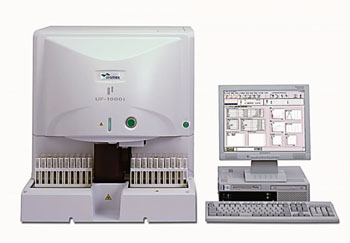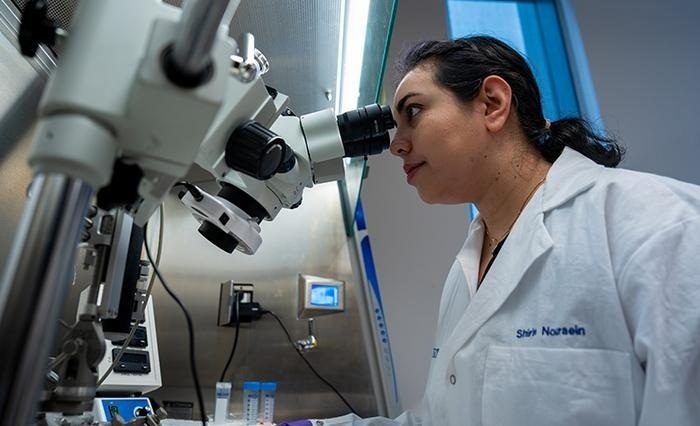Urinary Tract Infection Tracked by Routine and Automated Urinalysis
|
By LabMedica International staff writers Posted on 13 Sep 2016 |

Image: The UF-1000i fully automated urine particle analyzer (Photo courtesy of Sysmex Corporation).
Urinary tract infections (UTIs) are frequently encountered and the diagnosis of UTI using urine dipstick, Gram stain, urine culture often lack proven accuracy and precision in the emergency department (ED).
Because of its swiftness and low cost, urine dipstick (UD) is a commonly used test at the ED, but diagnostic accuracy is, however, based on primary care settings and therefore not compatible with the ED. UTI is confirmed by results of urine cultures (UCs), which are labor intensive, time consuming, and not available within the time frame of an ED visit.
Scientists at the University Medical Center Groningen (The Netherlands) analyzed a total of 381 cases presenting with fever and/or clinically suspected UTI. The following specific symptoms for UTI were determined: dysuria, pollakisuria, urinary urgency, hematuria, and back pain/lower abdominal pain. In addition, specific symptoms of UTI were determined: fever, chills, malaise, flank or perineal pain, and delirium.
For Gram staining, 10 μL of uncentrifuged urine was used. The color (gram negative or gram positive); shape (rods or cocci); and number of leukocytes, erythrocytes, and bacteria per high-power field (hpf) were determined semi-quantitatively at 100 × 10 magnification. The automated stick reader cobas u 411 was used with the UD Combur10 test (Roche Diagnostics, Mannheim, Germany). For UC, 1 μL of urine was inoculated on two agars (sheep blood agar and MacConkey3 agar) and incubated at 35°C for 16-20 hours in ambient air. Isolated organisms were measured semi-quantitatively as number of colony-forming units (CFU) per milliliter. For automated urine particle analysis, the team used the Sysmex UF-1000i (Sysmex Corporation, Kobe, Japan) is a fully automated urine particle analyzer based on flow cytometry.
The scientists reported 143 (37.5%) cases were diagnosed with UTI. Sensitivity of urine dipstick nitrite was 32.9% and specificity was 93.7%. Sensitivity of urine dipstick leukocyte esterase (3+) was 80.4% and specificity was 82.8%. Of the 143 cases with a UTI, 91 had a noninvasive UTI, 16 had a urosepsis confirmed by blood culture, 24 had a urosepsis based on clinical presentation, 11 had a pyelonephritis, and one had a prostatitis. Receiver operating characteristic curves of automated bacterial and leukocyte count showed area under the curve of 0.851 and 0.872, respectively. Cutoff values of 133 bacteria/μL and 48 leukocytes/μL resulted in a greater than 90% sensitivity.
The authors concluded that that in an unselected patient group presenting to the ED with suspected UTI, automated urine particle analysis with counts of leukocytes and bacteria results in comparable diagnostic accuracy compared with standard dipstick analysis but can slightly improve diagnostic accuracy, especially to make UTI unlikely, when added to standard clinical and UD analysis. The study was published in the August 2016 issue of the American Journal of Emergency Medicine.
Related Links:
University Medical Center Groningen
Roche Diagnostics
Sysmex Corporation
Because of its swiftness and low cost, urine dipstick (UD) is a commonly used test at the ED, but diagnostic accuracy is, however, based on primary care settings and therefore not compatible with the ED. UTI is confirmed by results of urine cultures (UCs), which are labor intensive, time consuming, and not available within the time frame of an ED visit.
Scientists at the University Medical Center Groningen (The Netherlands) analyzed a total of 381 cases presenting with fever and/or clinically suspected UTI. The following specific symptoms for UTI were determined: dysuria, pollakisuria, urinary urgency, hematuria, and back pain/lower abdominal pain. In addition, specific symptoms of UTI were determined: fever, chills, malaise, flank or perineal pain, and delirium.
For Gram staining, 10 μL of uncentrifuged urine was used. The color (gram negative or gram positive); shape (rods or cocci); and number of leukocytes, erythrocytes, and bacteria per high-power field (hpf) were determined semi-quantitatively at 100 × 10 magnification. The automated stick reader cobas u 411 was used with the UD Combur10 test (Roche Diagnostics, Mannheim, Germany). For UC, 1 μL of urine was inoculated on two agars (sheep blood agar and MacConkey3 agar) and incubated at 35°C for 16-20 hours in ambient air. Isolated organisms were measured semi-quantitatively as number of colony-forming units (CFU) per milliliter. For automated urine particle analysis, the team used the Sysmex UF-1000i (Sysmex Corporation, Kobe, Japan) is a fully automated urine particle analyzer based on flow cytometry.
The scientists reported 143 (37.5%) cases were diagnosed with UTI. Sensitivity of urine dipstick nitrite was 32.9% and specificity was 93.7%. Sensitivity of urine dipstick leukocyte esterase (3+) was 80.4% and specificity was 82.8%. Of the 143 cases with a UTI, 91 had a noninvasive UTI, 16 had a urosepsis confirmed by blood culture, 24 had a urosepsis based on clinical presentation, 11 had a pyelonephritis, and one had a prostatitis. Receiver operating characteristic curves of automated bacterial and leukocyte count showed area under the curve of 0.851 and 0.872, respectively. Cutoff values of 133 bacteria/μL and 48 leukocytes/μL resulted in a greater than 90% sensitivity.
The authors concluded that that in an unselected patient group presenting to the ED with suspected UTI, automated urine particle analysis with counts of leukocytes and bacteria results in comparable diagnostic accuracy compared with standard dipstick analysis but can slightly improve diagnostic accuracy, especially to make UTI unlikely, when added to standard clinical and UD analysis. The study was published in the August 2016 issue of the American Journal of Emergency Medicine.
Related Links:
University Medical Center Groningen
Roche Diagnostics
Sysmex Corporation
Latest Microbiology News
- Rapid POC Tuberculosis Test Provides Results Within 15 Minutes
- Rapid Assay Identifies Bloodstream Infection Pathogens Directly from Patient Samples
- Blood-Based Molecular Signatures to Enable Rapid EPTB Diagnosis
- 15-Minute Blood Test Diagnoses Life-Threatening Infections in Children
- High-Throughput Enteric Panels Detect Multiple GI Bacterial Infections from Single Stool Swab Sample
- Fast Noninvasive Bedside Test Uses Sugar Fingerprint to Detect Fungal Infections
- Rapid Sepsis Diagnostic Device to Enable Personalized Critical Care for ICU Patients
- Microfluidic Platform Assesses Neutrophil Function in Sepsis Patients
- New Diagnostic Method Confirms Sepsis Infections Earlier
- New Markers Could Predict Risk of Severe Chlamydia Infection
- Portable Spectroscopy Rapidly and Noninvasively Detects Bacterial Species in Vaginal Fluid
- CRISPR-Based Saliva Test Detects Tuberculosis Directly from Sputum
- Urine-Based Assay Diagnoses Common Lung Infection in Immunocompromised People
- Saliva Test Detects Implant-Related Microbial Risks
- New Platform Leverages AI and Quantum Computing to Predict Salmonella Antimicrobial Resistance
- Early Detection of Gut Microbiota Metabolite Linked to Atherosclerosis Could Revolutionize Diagnosis
Channels
Molecular Diagnostics
view channel
New Serum Marker-Editing Strategy to Improve Diagnosis of Neurological Diseases
Tracking gene-expression changes in the brain is crucial for understanding neurological diseases, yet current monitoring tools are invasive or unable to capture subtle activity shifts over time.... Read more
World’s First Genetic Type 1 Diabetes Risk Test Enables Early Detection
Type 1 Diabetes (T1D) affects more than eight million people worldwide, with numbers expected to rise sharply. While most cases are genetically driven, only one in ten patients has a family history, making... Read moreHematology
view channel
Platelet Activity Blood Test in Middle Age Could Identify Early Alzheimer’s Risk
Early detection of Alzheimer’s disease remains one of the biggest unmet needs in neurology, particularly because the biological changes underlying the disorder begin decades before memory symptoms appear.... Read more
Microvesicles Measurement Could Detect Vascular Injury in Sickle Cell Disease Patients
Assessing disease severity in sickle cell disease (SCD) remains challenging, especially when trying to predict hemolysis, vascular injury, and risk of complications such as vaso-occlusive crises.... Read more
ADLM’s New Coagulation Testing Guidance to Improve Care for Patients on Blood Thinners
Direct oral anticoagulants (DOACs) are one of the most common types of blood thinners. Patients take them to prevent a host of complications that could arise from blood clotting, including stroke, deep... Read moreImmunology
view channel
Gene Signature Test Predicts Response to Key Breast Cancer Treatment
DK4/6 inhibitors paired with hormone therapy have become a cornerstone treatment for advanced HR+/HER2– breast cancer, slowing tumor growth by blocking key proteins that drive cell division.... Read more
Chip Captures Cancer Cells from Blood to Help Select Right Breast Cancer Treatment
Ductal carcinoma in situ (DCIS) accounts for about a quarter of all breast cancer cases and generally carries a good prognosis. This non-invasive form of the disease may or may not become life-threatening.... Read moreMicrobiology
view channelRapid POC Tuberculosis Test Provides Results Within 15 Minutes
Tuberculosis remains one of the world’s deadliest infectious diseases, and reducing new cases depends on identifying individuals with latent infection before it progresses. Current diagnostic tools often... Read more
Rapid Assay Identifies Bloodstream Infection Pathogens Directly from Patient Samples
Bloodstream infections in sepsis progress quickly and demand rapid, precise diagnosis. Current blood-culture methods often take one to five days to identify the pathogen, leaving clinicians to treat blindly... Read morePathology
view channelAI Tool Outperforms Doctors in Spotting Blood Cell Abnormalities
Diagnosing blood disorders depends on recognizing subtle abnormalities in cell size, shape, and structure, yet this process is slow, subjective, and requires years of expert training. Even specialists... Read more
AI Tool Rapidly Analyzes Complex Cancer Images for Personalized Treatment
Complex digital biopsy images that typically take an expert pathologist up to 20 minutes to assess can now be analyzed in about one minute using a new artificial intelligence (AI) tool. The technology... Read moreTechnology
view channel
AI Saliva Sensor Enables Early Detection of Head and Neck Cancer
Early detection of head and neck cancer remains difficult because the disease produces few or no symptoms in its earliest stages, and lesions often lie deep within the head or neck, where biopsy or endoscopy... Read more
AI-Powered Biosensor Technology to Enable Breath Test for Lung Cancer Detection
Detecting lung cancer early remains one of the biggest challenges in oncology, largely because current tools are invasive, expensive, or unable to identify the disease in its earliest phases.... Read moreIndustry
view channel
Abbott Acquires Cancer-Screening Company Exact Sciences
Abbott (Abbott Park, IL, USA) has entered into a definitive agreement to acquire Exact Sciences (Madison, WI, USA), enabling it to enter and lead in fast-growing cancer diagnostics segments.... Read more









 assay.jpg)














